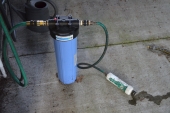Fun lesson. What you posted didn't match my understanding so just took a googling lesson in chloramines and you were right and my understanding was faulty. I originally thought chloramines were by product of treatment with chlorine and wasn't aware that they were also added for water sterilization.
Looked at dozens of articles but this one sort of sums it up.
chloramine removal
That said the common chemical treatments would cause an increase in salt in your soil so for both expense and salt build up are not workable.
UV treatment might work but it takes long exposures so likely not valid.
And the others are knocked off for similar reasons.
So that leaves the catalytic carbon filters as your best option still. If the flow rate is not good enough can you simply put more in parallel? 4 of them in parallel should get you the flow rate you want. Since they are processing the same number of gallons either way life expectancy per filter should be the same so you should only have to change them out 1/4 as often. One question here is have you checked your water quality out of the filters? The articles seem to say the water needs to move really slowly thru the filters for most effective removal.
The other answer I see is can you automate your watering system? 40 hours a week watering doesn't sound like a problem if you are not involved in the process.
If you test your output water you might find you need 8 or 10 filters in parallel and to water continuously under automation to get slow enough flow for the filters to do the job.

 1
1




 2
2









 3
3




 2
2




 2
2




 1
1









